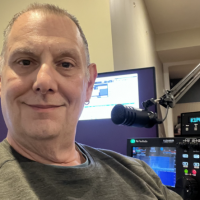Welcome to the FlexRadio Community! Please review the new Community Rules and other important new Community information on the Message Board.
Need the latest SmartSDR or 4O3A Genius Product Software?
SmartSDR v4.1.3 | SmartSDR v4.1.3 Release Notes
SmartSDR v3.10.15 | SmartSDR v3.10.15 Release Notes
The latest 4O3A Genius Product Software and Firmware
SmartSDR v4.1.3 | SmartSDR v4.1.3 Release Notes
SmartSDR v3.10.15 | SmartSDR v3.10.15 Release Notes
The latest 4O3A Genius Product Software and Firmware
If you are having a problem, please refer to the product documentation or check the Help Center for known solutions.
Need technical support from FlexRadio? It's as simple as Creating a HelpDesk ticket.
Need technical support from FlexRadio? It's as simple as Creating a HelpDesk ticket.
PSDR to SSDR: Two Things I Miss Most

Peter K1PGV
Member ✭✭✭
I successfully made the transition from PSDR (Flex-1500) to SSDR (Flex-6500) on Friday. I was up and running in less than an hour (including installing a new computer). It took me the better part of a day to move all my software and to start to get my station re-configured.
First, kudos to the Flex team. This is one brilliant radio. The integrated CAT and DX features are very cool (despite a few glitches). But you all knew all that, and it's not the main reason for my posting.
There are two things I immediately and sorely miss in moving from PSDR to SSDR. I wanted to capture them. You might be surprised what they are:
Thanks...
Peter
K1PGV
First, kudos to the Flex team. This is one brilliant radio. The integrated CAT and DX features are very cool (despite a few glitches). But you all knew all that, and it's not the main reason for my posting.
There are two things I immediately and sorely miss in moving from PSDR to SSDR. I wanted to capture them. You might be surprised what they are:
- Tuning by hovering the cursor over the desired frequency digit and turning the scroll wheel. This was super handy in PSDR and I used it all the time. Tuning in SSDR works, but it's not cool at all. You can "edit" the frequency, but you have to guess where your cursor is before you start typing. Can we please get PSDR-style tuning in SSDR? Pretty please?
- User-defined receive bandwidth buttons. Surprise, but not having this little feature is killing me when I operate digital modes. You see, I have a set of macros defined in my digital-mode program that, with the click of a button, will center the given station at +2000 in my waterfall and select the a given digital filter with the signal centered. My filter selection widths were: 50Hz, 250Hz, 500Hz, and 6KHz. This was accomplished in SSDR by sending a ZZFI0x; command, where "x" is the appropriate filter button. While we still have the ZZFIxx command, unless I can define my own receive bandwidth buttons there's no way for me to accomplish my former functionality.
I also miss the user-definable bandwidth buttons just changing among various modes. I want to see a *lot* of spectrum by default in my digital mode program's waterfall, and the largest bandwidth button provided today (3K) is not nearly wide enough for me.
While having user-definable receive buttons would be great, for solving the CAT issue I think the best thing would be to have a CAT command that allowed you to set the RX A DSP filter low and high frequencies to arbitrary values. Something like ZZFLxxxx; and ZZFHxxxx; which allow you to specify the high and low cut-offs respectively. This seems like something that would be generically useful.
Thanks...
Peter
K1PGV
2
Answers
-
Use profiles to define bandwidth. Very easy to set up digital profiles. No need to swap around with macros0
-
Thanks for the suggestion, but no... that really won't help. There is a need, at least for my style of digital mode operating, to "swap around with macros."
Consider when you're working a contest or chasing DX, and working your way down the waterfall in your digi-mode program. I want to see a nice, wide, waterfall showing me an overview of what's going on (and an even wider view in the SSDR panadaptor). So I click my "Wide" to get that arrangement.
I find a station I think might be interesting. After listening for a while, I want to try to call him. I click my "250Hz" button to move this station to offset 2000 in my waterfall, and to narrow the DSP bandwidth to 125Hz each side of the station.
If I'm hearing to much QRN/M, I might click my "narrow" button which puts the station in the center of a 50Hz filter.
When I've got him in the log, I click my "Wide" button again, and go back to searching.
Of course, you can only do this if you can control the low-cut and high-cut of the RX filter via CAT control... OR select a pre-defined bandwidth button by index, which is what I've been doing since the SDR-1000.
de Peter K1PGV0 -
Double clicking on the frequency display will high light it, then you can enter the frequency via your keypad. You can adjust the filter width by adjusting it to what you want then save it in the Transmit profile list. I have custom FBW for most of my dedicated digital apps. The Profiles are wonderful the global profile will also remember the transmit profile that you desire. The new Profile system has solved 95 % of my setup problems and now makes it easy to set for what ever I want to do.
0
Leave a Comment
Categories
- All Categories
- 377 Community Topics
- 2.1K New Ideas
- 630 The Flea Market
- 8.2K Software
- 112 SmartSDR+
- 6.4K SmartSDR for Windows
- 183 SmartSDR for Maestro and M models
- 428 SmartSDR for Mac
- 271 SmartSDR for iOS
- 258 SmartSDR CAT
- 190 DAX
- 382 SmartSDR API
- 9.3K Radios and Accessories
- 36 Aurora
- 252 FLEX-8000 Signature Series
- 7.2K FLEX-6000 Signature Series
- 944 Maestro
- 55 FlexControl
- 865 FLEX Series (Legacy) Radios
- 919 Genius Products
- 461 Power Genius XL Amplifier
- 335 Tuner Genius XL
- 123 Antenna Genius
- 296 Shack Infrastructure
- 208 Networking
- 454 Remote Operation (SmartLink)
- 144 Contesting
- 787 Peripherals & Station Integration
- 139 Amateur Radio Interests
- 1K Third-Party Software

